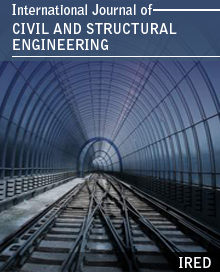High performance concrete using recycled aggregate, Microsilica and synthetic macro fibre
Author(s) : AJIBOLA TIJANI, JIAN YANG, SAMIR DIRAR
 Abstract
Abstract
The conventional ballasted rail track system incorporating steel tendon in prestressed concrete sleepers is predominantly used throughout the railway network in the UK. Despite its benefits, the associated demerits and the need to revolutionise rail transportation in the UK necessitated this investigation. The objective was to determine physical and mechanical characteristics of recycled aggregate concrete incorporating synthetic macro fibre and mineral admixtures to develop a low maintenance and corrosion-free prestressed concrete sleepers which is a high strength structural application. These materials were incorporated with varying percentage replacement (i.e. 0%, 25%, 50%, 75% & 100% respectively) of natural coarse aggregate by recycled aggregate, 54mm forta-ferro synthetic macro fibre dosage (0.11% and 0.5%), 5% dosage of Microsilica and 0.4% High Range Superplasticiser by weight of cement. A total of 621 concrete samples (cubes, cylinders & prisms) were subjected to workability test, density measurement, modulus of elasticity, compressive strength, flexural strength, and tensile splitting strength test in four different phases. Results obtained from phases 1, 2, and 3 indicate reduction in workability, density, modulus of elasticity, compressive strength, tensile splitting strength, and flexural strength of recycled aggregate concrete without mineral and chemical admixtures as the percentage content of recycled coarse aggregate increased compared with the control concrete samples and no significant effect was observed from dosage of synthetic macro fibre. The addition of microsilica and superplasticiser to the concrete mix in phase 4 brought about great improvement in workability, density, compressive strength, flexural strength, and tensile splitting strength and this was evident from 1, 7, and 28 curing days’ strengths respectively. This enhanced strength could be associated with the densifying quality and pozzolanic action of microsilica. Recycled aggregate concrete without fibre dosage (phase 2) performed satisfactorily up to 25% replacement, while 50% replacement produced 97% of the target compressive strength, which indicates the possibility of raising the current recommended optimum use of recycled aggregate in concrete production from 25% to 50%.

About Journals
- ISSN No. : 2372-3971
- Editor Chief : Dr. Cristina Gentilini, Alma mater Studiorum - University of Bologna, Italy
- Related Subjects : Corrosion Of Reinforcement In HVFA Concrete, Advanced Construction Materials : Microsilica In Concrete, Oceans as a Non-conventional Source of Energy, Silica Fume Concrete
 Full Paper PDF
Full Paper PDF